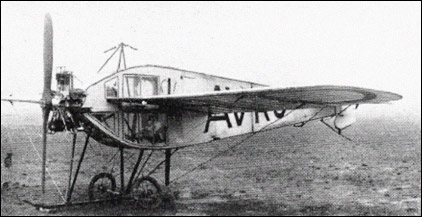|
| There is no text information for this aircraft at the moment.
 | A three-view drawing (800 x 683) |
| Roger Markman, e-mail, 05.10.2011 22:27 I think that the replica is absolutely superb! It is far more beautiful in the flesh, as it were, than in photographs.
May I offer a suggestion?
Run a competition for the Manchester Aviation Art Society to produce paintings of the Type F.
Choose a winner and sell prints of the winning picture in the museum shop. This print could have details of the restoration project and a limited number could be signed by all those who built the aircraft, to be sold at a higher price.
I'm sure that the print could be made in house at very low cost, just make sure that acid free paper is used and colour fast inks. They could be sold in tubes or ready framed. Framed they would create a secondary profit from the framing.
Why not????? reply | | BC Hucks, e-mail, 19.01.2011 12:40 The Avro Type F was designed by AV Roe in 1911 as a possible entrant for a competition for military aircraft. Roe believed that open cockpits exposed pilots to collisions with birds and insects and so built the Type F with an enclosed cabin. Detailed drawings of the aeroplane were completed by Roe's students at Brooklands. These were based on sketches and dimensions provided by Roe. The draughtsmen included British Westinghouse trained Sydney Sippe and Indian SV Setty /Setti. Sippe was working for Avro in exchange for flying lessons /experience. Setty was gaining experience of aircraft design and manufacture, as well as learning to fly. India now regards Setty as the nation's first aircraft designer. Construction of the Type F began in the Avro worskshop in the basement of Brownsfield Mill, Ancoats, Manchetser, in January 1912. The competed aircraft travelled to Weybridge by train n April, and was wheeled through the streets to the Brooklands racing circuit and flying ground. Jack Alcock, later the first pilot to fly non-stop across the Atlantic, fitted a second hand Viale 35 horsepower engine to the Type F. Wilfred Parke made the first flight of the Type F on 3 May 1912. This was the first flight of an enclosed monoplane. Flight-testing continued until 17 May, when a maximum altitude of 1,000 feet was reached. The initial rate of climb was about 300 feet /minute and top speed was about 65 miles per hour. Unfortunately the Viale had a tendency to overheat after about 30 minutes and this caused a loss of power. On 25 May Parke took off from Brooklands to fly to Hendon. The engine failed soon after take-off and forced Parke to land at Weybridge. Parke hit a wire fence as he came down causing the Avro F to turn over and crash. Damage was slight and the Type F was dismantled by four men in 25 minutes and returned to the Avro workshop at Brooklands for repair. Meanwhile the specification had been published for the type of aeroplane wanted by the British Army. As the Type F could only carry one person the design was not suitable. Therefore AV Roe design the Type G Military Trials aeroplane which combined features of the Type F witht he successful Type E biplane. As construction of two Type G biplanes got underway interest inthe Type F declined. The aircraft remained in a nhangar at Brooklands until Harold Barnwell attempted to fly it on 13 September, 1912. After only one or two straight 'hops' Barnwell was attempting to take off when the point of the undercarriage skid dug in to the ground and the Type F turned over. Barnwell escaped unhurt but the Avro Type F did not fly again. The Viale engine, however, was fitted to the Bristol Babe biplane in 1919. After becoming part of the Nash Collection, the Viale is owned by the Royal Aeronautical Society, currently, and can be seen on display in the Science Museum in London. A static replica of the Avro F is on display in the "Revolution Manchester" gallery at the Museum of Science and Industry (MOSI) in Manchester. reply | | Mercedes Foster, e-mail, 07.10.2010 18:25 you really need to get more info on here so students can actually LEARN about this plane! reply |
|
Do you have any comments?
|
| 
COMPANY
PROFILE
All the World's Rotorcraft
|











